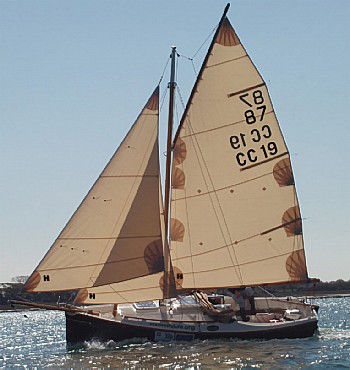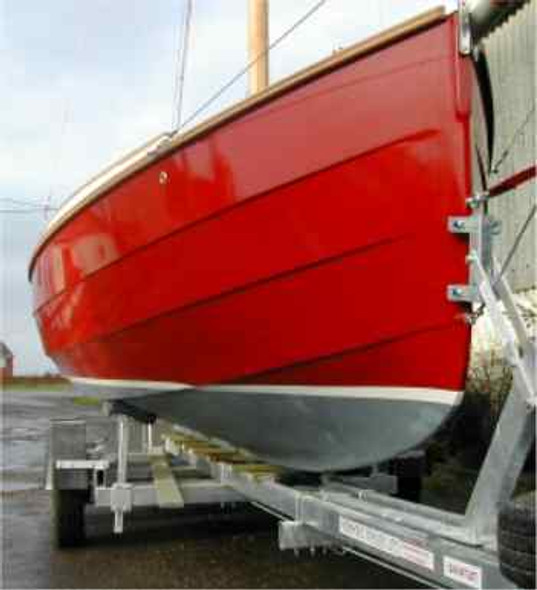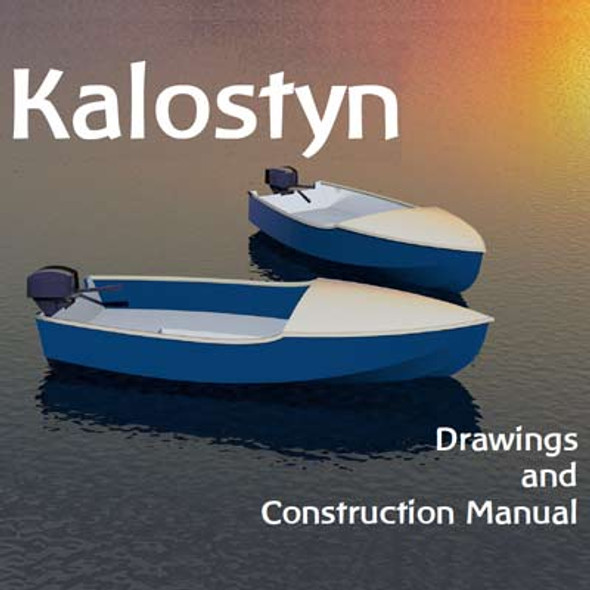Description

Gunkholing at its best.
"Zest" (hull #2) snug in a tiny cove
along the shores of False Bay

Pretty as a picture
~ The charm of tradition
~ Accommodation for family weekending
~ Comfortable cockpit
~ Towing behind the family car
~ Choice of gaff or marconi rig
~ Shallow draft to access favorite spots
~ Plywood plans for amateur builders
The Cape Cutter 19 was commissioned by Cape Cutter Yachts, as a GRP production trailer-sailer. Their brief was very particular in requiring a little cruiser which was to be traditional workboat in image, with lots of character, shallow draft and good sailing characteristics. She also had to fit inside a 6m (20ft) shipping container for economical transportation to international markets.
There are already other designs which fit some or all of those criteria, so part of our job was to draw a boat to satisfy those needs in a different way. I believe that we fulfilled this need and added valuable features as part of the process.


The Hull
I took the unusual step with this one of drawing the lines on paper then moving them across into the computer lines fairing program for final fairing. I did this because it is easier to assess the aesthetics and proportions of a chine or lapstrake hull on paper than on a computer screen. I felt that I would produce a prettier hull this way.
The next step was to move it across into a 3D modelling program, which allowed us to generate accurate full size patterns of all of the skin panels. This, along with full size framing patterns, speeded up the building process of the plug. It produced basic plug surfaces that were relatively quick to bring to production plug standard.
She has a plumb bow and long waterline, to maximise top-end performance. The bow is fine down at waterline to allow her to punch through a wind chop, for good windward ability. This flares to a full plan shape at deck level, giving reserve buoyancy to resist bow burying and to keep her dry on deck.
Aft she is quite full on plan, with straight buttocks. This powerful stern gives her good reaching speed and the volume distribution to carry reasonable crew loads in the cockpit.
She has a long and shallow keel moulded in, which runs from the leading edge of the centre plate through to the outboard engine well. A rudder horn is bolted to the heel of the keel to give protection to the semi-balanced spade rudder, which is hung off the transom on pintles.

On Deck
Her deck layout has been drawn clean and simple, keeping the best spots available for the crew rather than occupying them with deck hardware and ropes.
She has a raised sheer and flush deck, maximising usable space both on deck and down below. The sunken self-draining foredeck acts as an oversize anchor well and also provides a comfortable spot to sit, both sailing and at anchor. She has a handrail/toerail detail along the deck edge, to give safer footing on deck and useful tie-on points for fenders etc.
Her cockpit is deep, giving good protection behind the cabin from wind and spray. The seats have comfortable backrests and the coamings are wide enough to sit on. The outboard engine well is in the cockpit footwell, with a dam formed around it to contain accidental fuel or oil spillage which may otherwise make the sole area slippery. Drainage in the event of taking a large wave onboard will be very fast, via the engine well.
Halyards and headsail furling lines are led alongside the companion hatch and through stoppers to a pair of 6:1 winches on the aft end of the cabintop. Headsail sheets are led through pivoting fairleads with built-in camcleats to the same pair of winches or directly to the crew for hand control from whichever position suits them. Mainsheet blocks are mounted on the top of the transom and reefing lines have been kept on the boom. She can be reefed by one person standing in the companionway, from where all lines can be reached.
Centreplate and Ballast
Her centreplate, of approximately 100kg, is raised by means of a simple drum winch housed under the companionway step. Fixed ballast is lead, glassed over to form the cabin sole.

Mike Brooke sailing "Theo's Future" in the Solent in
preparation for his successful circum-navigation of
Great Britain in 2008.
Powerful Gaff or Marconi Rig
The gaff mast is the same length as the hull, so that it also fits easily into the shipping container while lashed to the deck. The marconi mast is built in two sections that can be separated for shipping inside the container. The joint is made with an internal sleeve and machine screws and is standard mast detailing.
Both rigs use a deck-stepped mast in a tall tabernacle and the boom is hinged off the tabernacle rather than the mast. This simplifies lowering the mast underway without first unshipping the boom. Shrouds go to outboard chainplates that are through-bolted to the hull.
She can be sailed with both headsails on close reaching to broad reaching courses in light to moderate winds. For beating she should be sailed with only the Genoa in light winds and only the staysail in stronger winds. The roller furling Genoa ensures good speed in lighter conditions and the ability to get rid of it quickly if needed. The hanked staysail gives a snug fully in-board rig for stronger winds and is easily lowered and snugged down if rigged with a downhaul line. The forestay goes to the stemhead, with the staysail hanked to it. The genoa furler has no stay in front of it, so the hinged bowsprit can be folded back to lie along the deck when not in use, if preferred by the crew. The bowsprit can also be used as a lever to assist in pulling the mast up into position for sailing, although it is easily raised by two people without use of the bowsprit for leverage.
The gaff and marconi mainsails are both of the same area and have roach and battens, for light air efficiency. They are fitted with two rows of reefing so that they can be snugged down for heavier conditions. Sheeting is through a 5:1 tackle system fitted to the top of the transom, and a boomvang to the base of the tabernacle helps to control mainsail twist.

Comfortable Weekending Accommodation
Down below she has an open layout, with sitting headroom all the way to the sides. With no sidedecks to get in the way, you can lounge back against her hull in comfort.
Her compact galley is equipped with single-burner cooker, sink and plenty of locker space. With berths for 4 adults, she is great for a small family. The quarter berths double as settees, with space for 2 people each side.
The Portapotti toilet is under the aft end of the forward berth. Located in a wide well, it is used athwartships rather than fore and aft. A privacy curtain can be fitted, hiding behind the galley lockers when not in use.

Chris & Kathryn Wicks's "Kaliope" cruising in the
Greek Isles, pulled up close to the beach for lunch.
Great Little Cruiser
All round, the Cape Cutter 19 makes a great little family cruiser. Being trailerable as well as safe for coastal cruising in reasonable conditions, she will open up your cruising options and expand your horizons.
This little boat has been very well received by the market. The GRP version has sold 60 boats in the 2 years since it was introduced into UK.

Build her in Plywood
Since the first showing of this design, we have received many enquiries after a plywood version. This is now available in a comprehensive plywood design package. The layout has been very slightly changed to suit the construction requirements of plywood but she is the same pretty, seaworthy and speedy little cruiser. We received orders for 20 sets of plywood plans in the first 9 months after completing them.
Hull construction is plywood lapstrake over stringers and plywood backbone. Stringers are notched into the bulkheads and the backbone is locked into the bulkheads egg crate-fashion.
The stock plan package includes full size patterns of the bulkheads plotted on stable mylar. These are plotted in colour to make them easier to follow and minimise chances of builders making a mistake. We also offer an optional extra of full size mylar patterns for the hull skin panels if you feel that you need help you through the process of laying out these panels. These patterns can be ordered with the stock plan package or later.
A CNC cut plywood kit for all components was available for a few months; unfortunately we have had to withdraw this option. If you want to build from a kit, please look at her new bigger sister, the Cape Henry 21, for which a kits are available.

Section through plywood version
Bjorn Cook received his new Cape Cutter 19 in Singapore from Honnor Marine in May 2009. After his first sail, he sent the following report to me. "I started sailing Gaffs back in Norway when I was around 12 or so - upwind these never were any great shakes, but this little boat has the temerity to get well inside 45 degrees upwind. (Pessimistically I set the Tabs on the Windex at 90 degrees). Using this as guidance - I reckon around 30 to 35 degrees was the closest we could keep her on main and jib only in the soft winds we have here this time of year - being 5 to 6 kts on a really good day. For a Gaff rig this is pretty good all told.
During this week I'll get the Genoa up - then we'll see - but so far - all I can conclude in saying: A great design, a great little boat that sails real well."
Bill Of Materials
MARINE PLYWOOD 1,22x2,44m (4'x8') (preferably Gaboon or Okoume plywood)
9mm (3/8") - 30 sheetsSAWN PINE (for building stocks etc)
25X125mm (1"x5") (rails) - 17m
50x50mm (2"x2") (bulkhead legs) - 12m
75x75mm (3"x3") (posts) - 5mSOLID TIMBER (meranti, mahogany, Douglas fir or similar, selected, free of knots, shakes fractures etc. Sizes are finished sizes.
12x30mm (1/2"x1 1/4") (washboard slides) - 5m (17')
12x87mm (1/2"x3 7/16") (framing to centreplate casing) - 2m (7')
16x16mm (5/8"x5/8") (hatch trims) - 2m (7')
20x56mm (3/4"x2 3/16") (toerail bases) - 2m (7')
22x22mm (7/8"x7/8") (hull stringers, framing, joinery cleats) - 135m (443')
22x25mm (7/8"x1") (framing to centreplate casing) - 2m (7')
22x26mm (7/8"x1 1/32") (cockpit locker framing) - 2m (7')
22x32mm (7/8"x1 1/4") (deck stringers, framing) - 60m (197')
22x41mm (7/8"x1 5/8") (cockpit locker framing) - 2m (7')
22x44mm (7/8"x1 3/4") (berth bearers, toerails) - 12m (40')
25x110mm (1"x4 5/16") (framing to centreplate casing) - 1m (4')
32x50mm (1 1/4"x2") (hatch coaming) - 3m (10')
42x55mm (1 5/8"x2 5/32") (hatch garage front) - 1m (4')
44x44mm (1 3/4"x1 3/4") Triangular fillet (cockpit locker framing) - 2m (7')
44x70mm (1 3/4"x2 3/4") (Keel, engine well kerb) - 12m (40')
80x80mm (3 3/16"x3 3/16") (Samson post) - 0.3m (1')RESIN & GLASS (for coatings and reinforced areas) Epoxy resin (low viscosity 100% solids) - 40kg (88lb)
75mm (3") Wide tape - 16m (55')
100mm (4") Wide tape - 11m (36')
450g/sq. m Chopped strand mat - 3sq. m (33sq. ft)The above list of materials is approximate and intended for calculation of approximate costs. We offer no guarantees of accuracy.
The list is for all timber in the construction of hull, deck and interior, including building stocks, temporary bracing etc. Allowance has been made in the quantities for wastage, with the exception of the building stocks and chipboard, which are net.
The plywood quantity is our estimate and will vary from builder to builder due to differences in efficiency. Simon Ballantine built his Cape Cutter 19 in UK, using our optional Mylar patterns for hull skin panels. He used 23 sheets of plywood to complete his boat.
Note that this design is not available for series building by any builder other than Cape Cutter Yachts.
Please note that our plan prices include for adding imperial measurements to our metric designs if needed by the buyer.
GRP or Plywood Lapstrake Traditional Trailer-sailer
LOD 5.80m (19'0")
LWL 5.50m (18'0")
Beam moulded 2.20m (7'3")
Draft 0.45/1.22m (1'6"/4'0")
Sail Area/Displ 23.3
Displ light 870kg (1918lb)
Ballast 380kg (838lb)
Additional Information
Note: |
plans have both metric and imperial dimensions and include Mylar bulkhead patterns |
Designer Name: |
Dudley Dix |
Sail area (Imperial / Metric): |
253 sq.ft / 23.52 sq. m |
Rig Type: |
Cutter, Gaff |
Ballast Type: |
Fixed |
Ballast Weight: |
838lb / 380kg |
Keel Type: |
Centerboard, Bilge Keels |
Rudder: |
Fixed |
Length (range): |
16' - 23'11" / 4.88m - 7.29m |
LOA: |
19'0" / 5.8m |
Length at Waterline: |
18'0" 5.5m |
Beam: |
7'3" / 2.2m |
Hull Weight: |
Over 1000 lb / 453.59kg |
Estimated Hull Weight: |
1920lb / 870kg |
Draft: |
12" - 35" / 30.48 - 91.23cm |
Unloaded Draft: |
1'11" / 0.6m bilge keels, 1'6"-4'0" / 0.45-1.22m centerplate |
Weight Capacity: |
1000lb / 450kg |
Primary Material: |
Marine Plywood |
Method of Construction: |
Lapstrake / Clinker |
Hull: |
Monohull |
Hull Type: |
Displacement |
Hull Shape: |
V bottom |
Cabin: |
Cabin |
Power Source: |
Internal Combustion, Wind |
Motor: |
Outboard |
Horsepower Rating: |
6hp / 4.5kW |
Built-in Floatation: |
No |
Trailerable: |
Yes |
Cartop: |
No |
Unit of Measure: |
Both |
Instruction Manual: |
General Instructions and Sequence |
Lofting Required: |
No |
Recommended Experience Level: |
Intermediate |
Designer's Thoughts on Experience Level: |
lapstrake plywood is a bit more complicated than stitch-&-glue |






